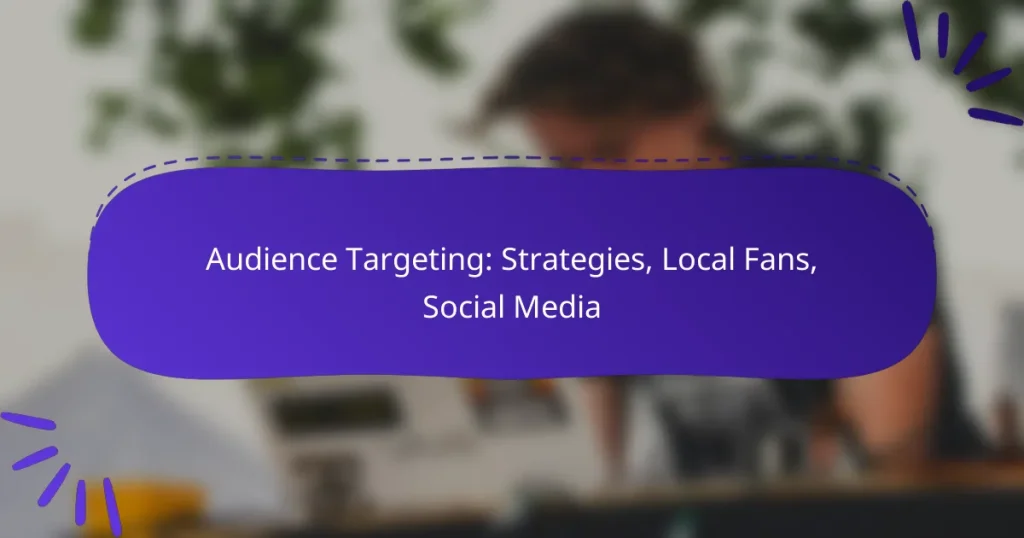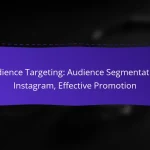Audience targeting is essential for e-commerce brands looking to connect with local fans and enhance their presence in the community. By leveraging strategies such as local search optimization, community engagement, and social media interaction, brands can create meaningful connections that resonate with their audience. Understanding audience behavior through analytical tools further enables businesses to tailor their marketing efforts for maximum impact.

How can e-commerce brands effectively target local audiences?
E-commerce brands can effectively target local audiences by implementing strategies that resonate with community preferences and behaviors. This involves optimizing for local search, engaging in community events, and collaborating with local influencers to build brand awareness and loyalty.
Utilizing local SEO strategies
Local SEO strategies are essential for e-commerce brands aiming to attract nearby customers. This includes optimizing website content with local keywords, ensuring accurate business listings on platforms like Google My Business, and gathering customer reviews that highlight local experiences.
Brands should focus on creating localized content, such as blog posts about local events or partnerships, which can improve visibility in search results. Regularly updating this content can lead to better engagement and higher rankings in local search queries.
Engaging with community events
Participating in community events allows e-commerce brands to connect directly with local audiences. Sponsoring local festivals, markets, or charity events can increase brand visibility and foster goodwill among residents.
Brands should consider setting up booths or offering samples at these events to create a personal connection. This hands-on approach not only promotes products but also demonstrates a commitment to the local community, enhancing brand loyalty.
Leveraging local influencers
Collaborating with local influencers can significantly amplify an e-commerce brand’s reach within a community. Influencers who resonate with local audiences can authentically promote products, making them more relatable and trustworthy.
Brands should identify influencers whose values align with their own and who have a genuine connection to the community. Offering them products for review or hosting joint events can create mutually beneficial partnerships that enhance brand credibility and attract local customers.
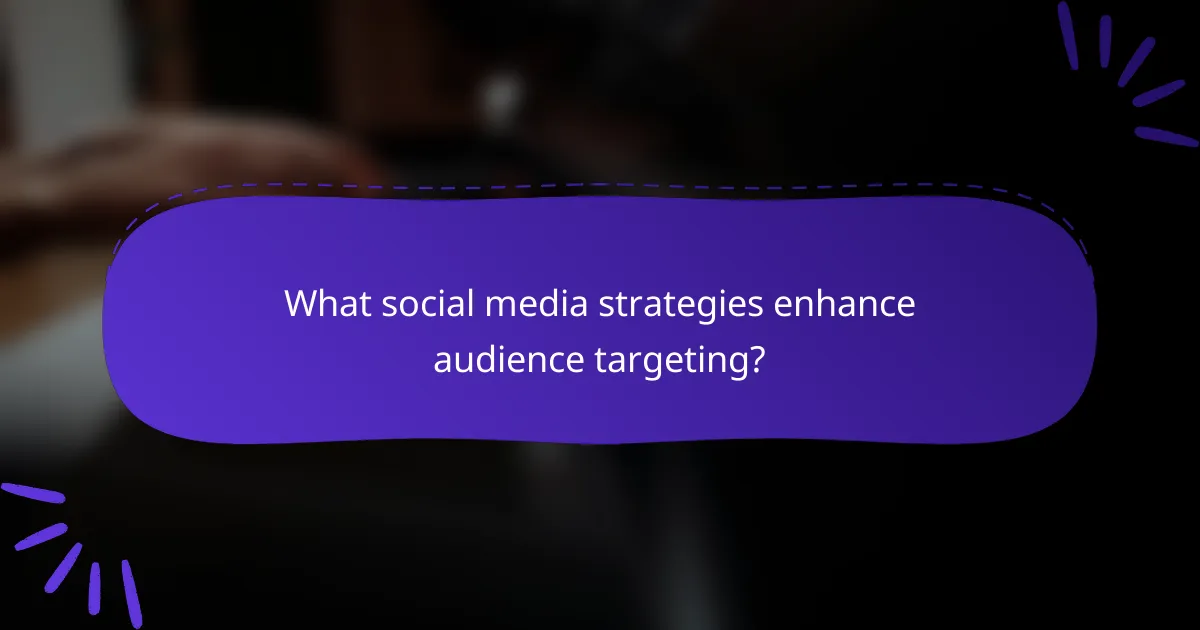
What social media strategies enhance audience targeting?
Effective social media strategies for audience targeting focus on creating relevant content, leveraging paid advertising, and fostering engagement. By understanding your audience’s preferences and behaviors, you can tailor your approach to maximize reach and impact.
Creating tailored content for platforms
Different social media platforms cater to distinct audiences and content types. For instance, Instagram thrives on visual storytelling, while LinkedIn is more suited for professional insights. Tailoring your content to fit these formats can significantly improve engagement rates.
Consider using short videos on TikTok or Instagram Reels to capture attention quickly, while longer, informative posts may perform better on Facebook or LinkedIn. Always keep your target demographic in mind when crafting your messages.
Utilizing targeted ads on Facebook
Facebook’s advertising platform allows for precise audience targeting based on demographics, interests, and behaviors. This means you can reach specific groups, such as local fans or niche markets, increasing the likelihood of conversion.
When setting up ads, use A/B testing to determine which visuals and messages resonate best with your audience. Allocate a budget that allows for flexibility, starting with a few hundred dollars to gauge performance before scaling up.
Engaging with followers through polls
Polls are an effective way to engage your audience and gather insights on their preferences. Platforms like Instagram and Twitter offer built-in polling features that make it easy to ask questions and receive immediate feedback.
Use polls to gauge interest in new products, content types, or event topics. This not only boosts engagement but also helps you tailor future content to better meet the needs of your audience, ensuring your strategies remain relevant and effective.
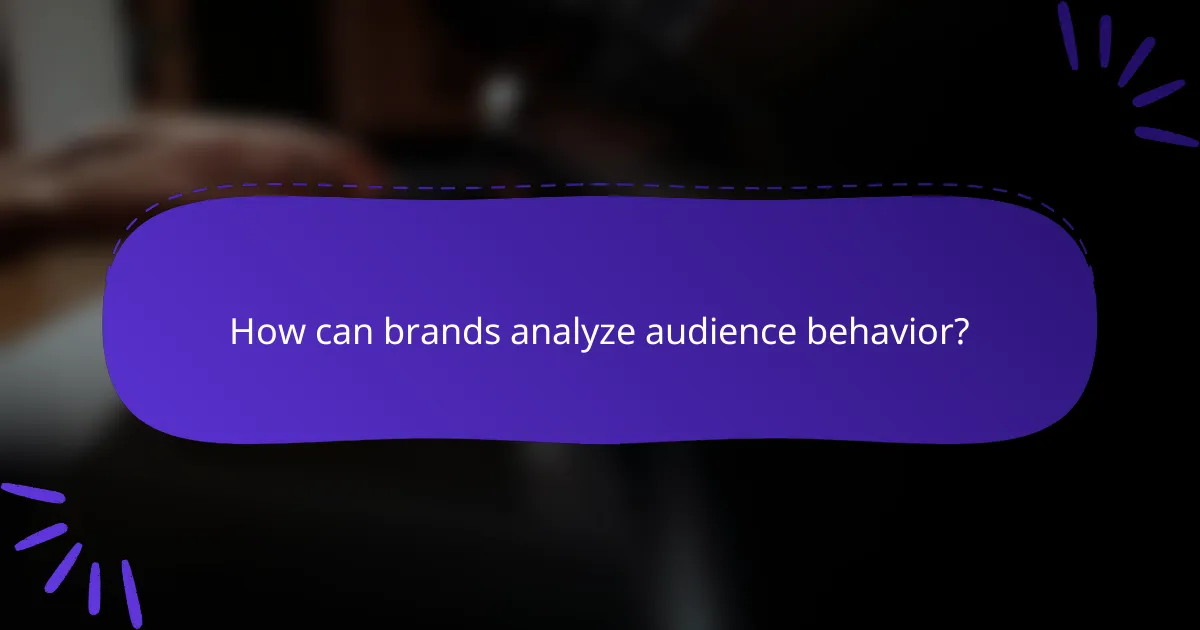
How can brands analyze audience behavior?
Brands can analyze audience behavior by utilizing various tools and methods to gather insights on how their target market interacts with their content. Understanding these behaviors helps in tailoring marketing strategies to better meet audience needs and preferences.
Using Google Analytics for insights
Google Analytics is a powerful tool that provides detailed insights into audience behavior on websites. Brands can track metrics such as page views, session duration, and bounce rates to understand which content resonates most with their audience.
To effectively use Google Analytics, set up goals that align with your business objectives, such as newsletter sign-ups or product purchases. Regularly review audience demographics and interests to refine your targeting strategies and improve engagement.
Conducting surveys and feedback sessions
Surveys and feedback sessions are direct methods to gather insights about audience preferences and behaviors. Brands can use online tools to create surveys that ask specific questions about customer experiences, product satisfaction, and desired features.
Consider incentivizing participation with discounts or exclusive content to increase response rates. Analyze the feedback to identify trends and areas for improvement, ensuring that your offerings align with audience expectations and needs.
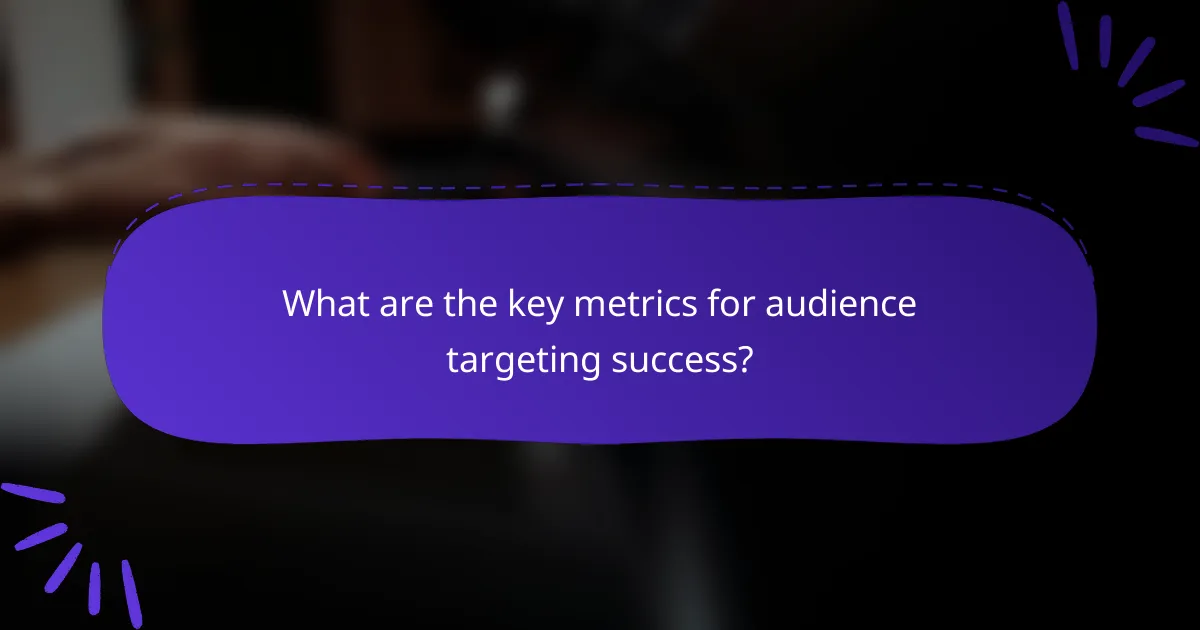
What are the key metrics for audience targeting success?
The key metrics for audience targeting success include conversion rates and engagement rates. These metrics help assess how effectively your campaigns reach and resonate with your intended audience, guiding future strategies.
Conversion rates from targeted campaigns
Conversion rates measure the percentage of users who take a desired action after engaging with a targeted campaign. This could include making a purchase, signing up for a newsletter, or downloading content. A successful conversion rate typically ranges from 2% to 5%, but this can vary based on industry and campaign specifics.
To improve conversion rates, ensure your messaging aligns with audience interests and needs. A/B testing different approaches can reveal what resonates best. Avoid common pitfalls like overly complex calls to action that may confuse potential customers.
Engagement rates on social media
Engagement rates on social media reflect how actively users interact with your content, including likes, shares, comments, and clicks. A healthy engagement rate often falls between 1% and 5%, depending on the platform and audience size. Higher engagement indicates that your content is relevant and appealing to your target demographic.
To enhance engagement rates, focus on creating high-quality, visually appealing content that encourages interaction. Utilize polls, questions, and user-generated content to foster community involvement. Regularly analyze engagement metrics to refine your strategy and avoid posting too frequently, which can lead to audience fatigue.

What tools assist in audience segmentation?
Audience segmentation tools help marketers identify and categorize their target audience based on specific characteristics, behaviors, and preferences. Effective tools streamline the process of gathering data, analyzing it, and implementing targeted strategies.
Using HubSpot for CRM
HubSpot’s Customer Relationship Management (CRM) platform offers robust audience segmentation features that allow businesses to organize contacts based on various criteria, such as demographics, behavior, and engagement levels. Users can create custom properties and lists to tailor marketing efforts effectively.
To maximize HubSpot’s capabilities, regularly update your contact data and utilize the reporting tools to analyze segment performance. This ensures that your targeting remains relevant and effective over time.
Employing Mailchimp for email targeting
Mailchimp provides powerful email targeting options that enable marketers to segment their audience based on engagement metrics, purchase history, and preferences. This allows for personalized email campaigns that resonate with specific groups, improving open and click-through rates.
When using Mailchimp, consider A/B testing different segments to refine your approach. Avoid over-segmenting, as this can complicate your campaigns and dilute your messaging. Aim for a balance that allows for targeted yet cohesive communication.
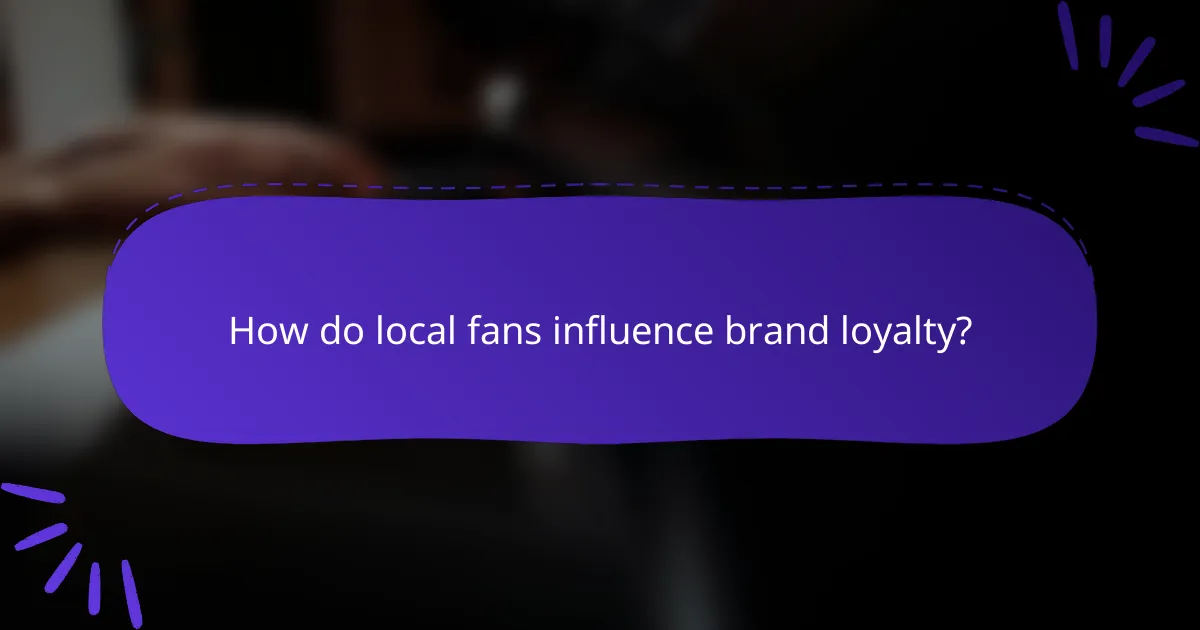
How do local fans influence brand loyalty?
Local fans significantly enhance brand loyalty by fostering a sense of community and belonging. When brands engage with their local audience, they create emotional connections that encourage repeat business and advocacy.
Building community through local events
Hosting local events allows brands to connect directly with their audience, strengthening relationships and loyalty. These events can range from product launches to community service initiatives, providing opportunities for face-to-face interactions.
Consider organizing events that resonate with local culture or interests, such as festivals, workshops, or charity runs. Engaging local influencers to participate can amplify your reach and credibility.
Creating localized marketing campaigns
Localized marketing campaigns tailor messages and promotions to reflect the unique characteristics of a specific area. This approach can include using local language, cultural references, and region-specific offers to resonate with the audience.
For example, a restaurant might highlight regional dishes or seasonal ingredients in their promotions. Utilizing social media platforms to share localized content can further enhance engagement, making fans feel valued and understood.
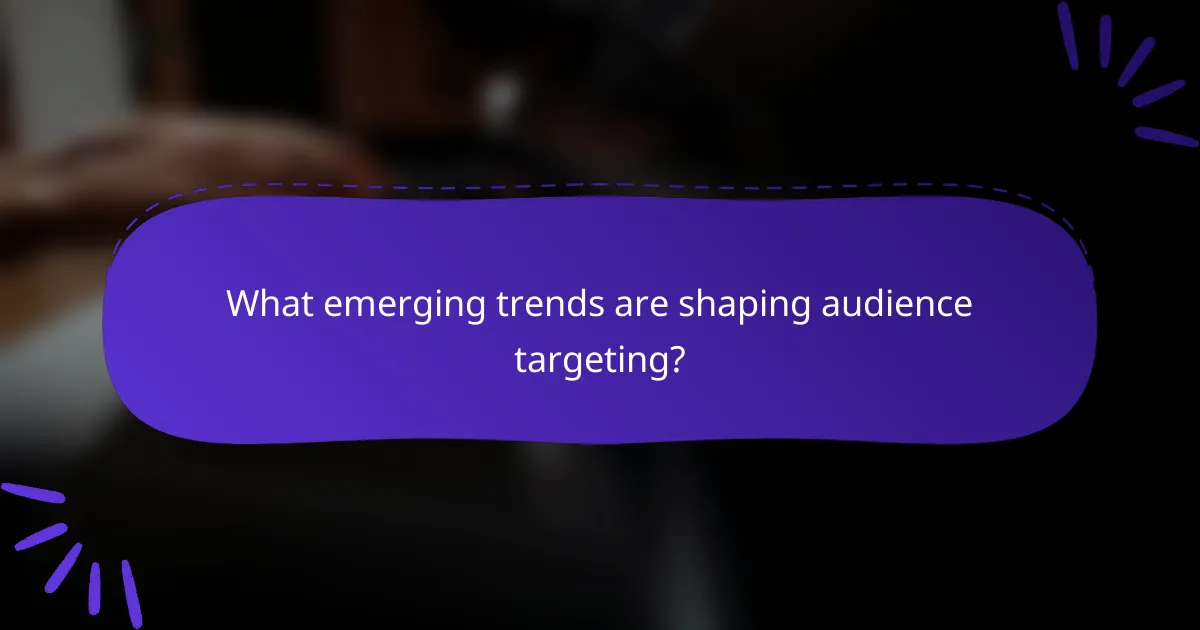
What emerging trends are shaping audience targeting?
Emerging trends in audience targeting are increasingly focused on personalization, data privacy, and the integration of artificial intelligence. Marketers are leveraging advanced analytics and machine learning to create tailored experiences while navigating the complexities of consumer privacy regulations.
Personalization through Data Analytics
Personalization is becoming essential in audience targeting, driven by sophisticated data analytics. Brands can analyze consumer behavior, preferences, and demographics to deliver customized content and offers. For example, e-commerce platforms often use browsing history to recommend products that align with individual interests.
To effectively implement personalization, businesses should invest in robust data collection methods and analytics tools. This enables them to segment their audience accurately and create targeted campaigns that resonate with specific groups.
Impact of Data Privacy Regulations
Data privacy regulations, such as the GDPR in Europe and CCPA in California, are reshaping how businesses approach audience targeting. Companies must ensure compliance while still gathering valuable insights about their customers. This often involves transparent data practices and obtaining explicit consent from users.
Organizations should regularly review their data handling processes to align with current regulations. Failing to comply can lead to significant fines and damage to brand reputation, making it crucial to prioritize ethical data usage.
Artificial Intelligence and Machine Learning
Artificial intelligence (AI) and machine learning (ML) are revolutionizing audience targeting by enabling more precise predictions and automated decision-making. These technologies analyze vast amounts of data to identify patterns and trends that human analysts might miss. For instance, AI can optimize ad placements in real-time based on user interactions.
Businesses looking to harness AI and ML should start with clear objectives and invest in the necessary technology. Collaborating with data scientists can help in developing models that enhance targeting strategies and improve overall marketing effectiveness.
